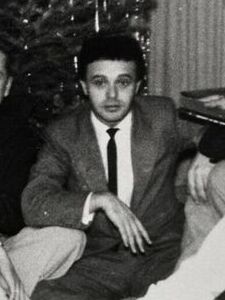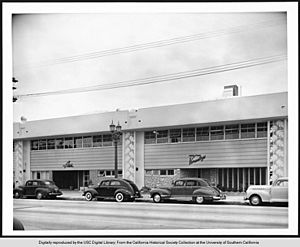Rudi Gernreich facts for kids
Quick facts for kids
Rudi Gernreich
|
|
|---|---|
 |
|
| Born | August 8, 1922 Vienna, Austria
|
| Died | April 21, 1985 (aged 62) Los Angeles, California, US
|
| Alma mater | Los Angeles City College |
| Occupation | Fashion designer |
| Years active | 1950–1985 |
| Known for | Designer of the monokini Avant-garde clothing designs Early supporter of the Mattachine Society |
| Partner(s) | Harry Hay (1950–1952) Oreste Pucciani (1953–1985; Gernreich's death) |
Rudolf "Rudi" Gernreich (August 8, 1922 – April 21, 1985) was an Austrian-born American fashion designer. His unique and bold clothing designs are seen as some of the most creative fashion of the 1960s.
He was known for using new materials like vinyl and plastic in clothes. He also used interesting cutouts in his designs. Rudi won the Coty American Fashion Critics Award four times. In 1966, he made what many consider the first fashion video, Basic Black: William Claxton w/Peggy Moffitt. He had a long and very influential career in fashion.
Rudi was also a founding member and supporter of the Mattachine Society. He often pushed the limits of what was considered acceptable fashion. He used his designs to share his thoughts on social issues and to change how people viewed clothing.
Contents
Early Life and Journey
Rudi Gernreich was the only child of Siegmund and Elisabeth Gernreich. They were a Jewish family living in Vienna, Austria. His father, a stocking maker, passed away when Rudi was eight years old.
Rudi learned about fashion from his aunt, Hedwig Müller. She owned a dress shop with her husband. He spent many hours there, sketching designs and learning about different fabrics. When he was 12, a designer named Ladislaus Zcettel saw his drawings. He offered Rudi an apprenticeship in London, but his mother thought he was too young to leave home.
Becoming a Refugee
In 1938, when Rudi was 16, Nazi Germany took over Austria. His mother and Rudi had to escape as Jewish refugees. They moved to the United States and settled in Los Angeles, California. To make money, his mother baked pastries, which Rudi sold door-to-door.
His first job was at the morgue of Cedars of Lebanon Hospital. He later said this experience made him "grow up overnight." He studied art at Los Angeles City College from 1938 to 1941. He also worked for a clothing maker in New York.
Fashion Career
Rudi briefly worked in Hollywood designing costumes, but he did not enjoy it. In 1942, he joined the Lester Horton's modern dance company. He was both a dancer and a designer there. Rudi said dancing helped him understand "what clothes did to the rest of the body." He left the dance company in 1948.
At that time, fashion trends mostly came from designers in Paris. In 1949, Rudi worked in New York. However, he felt forced to copy Parisian styles, which he disliked. He wanted to create his own unique designs.
In 1951, Rudi started designing his own clothes in Los Angeles and New York. He then signed a contract with Walter Bass in Beverly Hills. William Bass Inc. made a collection of dresses that were sold to Jax, a Los Angeles store known for bold clothing. Rudi also designed costumes for Lester Horton until 1952. For much of the 1950s, he worked with Renée Firestone in Los Angeles.
In 1955, he began designing swimwear for Westwood Knitting Mills. By 1959, he was their main swimwear designer. He also designed shoes for Genesco Corporation. After his contract with Walter Bass ended in 1960, he started his own company, G.R. Designs, in Los Angeles. He later changed its name to Rudi Gernreich Inc. in 1964.
In the early 1960s, Rudi opened a showroom in New York City. He showed his popular knitwear designs there. In 1966, he made a big move by signing a contract with Montgomery Ward, a chain store. This was unusual for a famous designer. His designs sold well at popular prices, showing that original fashion could be affordable.
In 1966, Women's Wear Daily called Gernreich one of the "fashion revolutionaries" in New York. He was recognized alongside other famous designers like Pierre Cardin and Mary Quant.
He designed the futuristic uniforms for the main characters in the 1970s science-fiction TV show Space: 1999. This showed his continued interest in pushing fashion boundaries.
Impact on Fashion Design
Rudi Gernreich was often compared to major fashion houses like Balenciaga and Dior. However, he preferred to show his designs in the U.S., not Paris. He said Claire McCardell was his inspiration. Rudi became known as a designer who broke many fashion rules.
As a former dancer, Rudi wanted clothes to allow the body to move freely. In 1952, he made the first swimsuit without a built-in bra. Most swimsuits at the time had stiff parts. His designs used stretchy wool knits that fit the body naturally.
Sports Illustrated magazine noted in 1962 that he had turned the dancer's leotard into a swimsuit. They said he "ripped out the boning and wiring that made American swimsuits seagoing corsets." He was seen as the designer who freed women from strict fashion. He created lively, young, and often bold clothing that followed the body's natural shape.
Some people consider Rudi Gernreich "the most innovative and dynamic fashion designer of the 20th century." He was featured on the cover of Time magazine in December 1967. The magazine called him "the most way-out, far-ahead designer in the U.S."
Cynthia Amnéus, a curator at the Cincinnati Art Museum, said Rudi was "one of the most important and visionary American fashion designers." She noted his "shocking and avant-garde things, like taking all the structure out of swimwear."
He worked closely with model Peggy Moffitt and photographer William Claxton. Together, they explored futuristic looks in clothing. His designs combined simple styles with bright colors and strong geometric patterns. Moffitt helped make his designs famous with her bold makeup and hairstyles.
Rudi was the sixth American designer to be chosen for the Coty American Fashion Hall of Fame. He designed the first see-through chiffon blouse. He also made clothes from leotards and tights, adding zippers and dog leash clasps. In 1970, he introduced the idea of unisex clothing. These were simple, practical clothes that could be worn by anyone.
From 1970 to 1971, he designed furniture. In 1975, he designed men's underwear. The next year, he worked on cosmetics and costumes for the Bella Lewitzky Dance Company. He also designed kitchen and bathroom accessories.
Rudi's minimalist bra design in 1964 changed bra design forever. It started a trend toward more natural shapes and soft, sheer fabrics.
Exhibitions and Recognition
Rudi's fashion was shown at the Fashion Institute of Technology in New York in 1967. An exhibition called "Fashion Will Go Out of Fashion" was held in Austria in 2000. In 2003, the Phoenix Art Museum in Arizona showed his work. They called him one of the most original and bold American designers from the 1950s to the 1970s. In 2019, the Skirball Cultural Center in Los Angeles created a major exhibition called Fearless Fashion: Rudi Gernreich.
Rudi received his first design award in 1956 from Sports Illustrated. He won the Wool Knit Association award in 1960. In 1963, he won two major awards, including the Coty American Fashion Critics Award. This award caused some debate, but many supported Rudi's recognition. He received the Coty Award again in 1963, 1966, and 1967.
Other awards included the Neiman Marcus award in 1961 and the Sunday Times International Fashion Award in 1965. Marylou Luther, a fashion editor, wrote that he was "considered the most inventive designer of these times."
In 1985, the Mayor of Los Angeles, Tom Bradley, declared August 13 as 'Rudi Gernreich Day'. This honored Rudi's contributions to fashion and Los Angeles. In 2012, Time magazine named him to its list of "All-TIME 100 Fashion Icons." In 2000, New York placed bronze plaques honoring American fashion designers, including Rudi, along Seventh Avenue.
Later Life
In his later years, Rudi Gernreich focused on making gourmet soups. He is known for a recipe for red pepper soup, a cold soup served in red pepper cases.
Personal Life
Rudi became a U.S. citizen in 1943. He met Harry Hay in July 1950. Rudi was a founding member and supporter of the Mattachine Society, a group working for social fairness.
In 1953, Rudi met Oreste Pucciani. Oreste was a key figure in bringing the ideas of Jean-Paul Sartre to American educators. He also played an important role in social movements. Rudi and Oreste were close friends for 31 years.
Rudi Gernreich passed away on April 21, 1985, at age 62, after being diagnosed with lung cancer. Oreste Pucciani later created a trust in their name for the American Civil Liberties Union.
See also
 In Spanish: Rudi Gernreich para niños
In Spanish: Rudi Gernreich para niños




